纳米二氧化钛通过调节 NLRP3/caspase-1/GSDMD通路诱导 HaCaT 细胞脓毒症。
IF 2.9
3区 医学
Q2 TOXICOLOGY
引用次数: 0
摘要
纳米二氧化钛(Nano-TiO2)被广泛应用于各行各业,并能通过多种生物屏障渗透人体组织。HaCaT 细胞系作为人类永生化角质细胞之一,通常被用作研究皮肤药物毒理学的模型。我们的目的是评估纳米二氧化钛对HaCaT细胞的毒性作用以及引发的焦细胞病变。我们采用MTT法评估了三种纳米二氧化钛粒径(15纳米、30纳米和80纳米)在不同浓度下对细胞活力的影响。随后,我们采用LDH、Hoechst 33342和碘化丙啶(PI)双重染色、扫描电子显微镜(SEM)、Western印迹(WB)和实时定量聚合酶链反应(RT-qPCR)来评估不同粒径在相同浓度下对细胞的影响。我们的研究结果表明,随着纳米二氧化钛浓度的增加,HaCaT细胞的存活率降低。此外,纳米二氧化钛增加了细胞上清液中的 LDH 水平。荧光双染色、扫描电镜、WB和RT-qPCR表明,纳米二氧化钛通过激活NLRP3/caspase-1/GSDMD的热蛋白沉积途径诱导细胞膜损伤。这些结果表明,纳米二氧化钛对HaCaT细胞的毒性受剂量和粒径的影响,并与诱导热蛋白沉积有关。日常生活中频繁、大量接触纳米二氧化钛可能会对健康造成严重危害。本文章由计算机程序翻译,如有差异,请以英文原文为准。
Nano titanium dioxide induces HaCaT cell pyroptosis via regulating the NLRP3/caspase-1/GSDMD pathway
Nano-titanium dioxide (Nano-TiO2) is extensively utilized across various industries and has the capacity to penetrate human tissues through multiple biological barriers. The HaCaT cell line, as one of human immortalized keratinocytes, is usually used as a model for studying skin drug toxicology. The objective was to assess the toxic effects of nano-TiO2 on HaCaT cells and to trigger pyroptosis. We used MTT method to evaluate the effects of three nano-TiO2 particle sizes (15 nm, 30 nm and 80 nm) on cell viability at different concentrations. Subsequently, we used LDH, Hoechst 33342 and propidium iodide (PI) double staining, scanning electron microscopy (SEM), Western blotting (WB) and real-time quantitative polymerase chain reaction (RT-qPCR) to evaluate the effects of different particle sizes on cells at the same concentration. Our findings indicated that HaCaT cell viability diminished with increasing nano-TiO2 concentrations. Moreover, nano-TiO2 increased LDH level in cellular supernatant. Fluorescence double staining, SEM, WB and RT-qPCR showed that nano-TiO2 induced cell membrane damage by activating pyroptosis pathway of NLRP3/caspase-1/GSDMD. These results suggest that nano-TiO2 toxicity in HaCaT cells is influenced by both dose and particle size, and is associated with the induction of pyroptosis. Frequent and large exposures to nano- TiO2 in daily life may cause serious health hazards.
求助全文
通过发布文献求助,成功后即可免费获取论文全文。
去求助
来源期刊

Toxicology letters
医学-毒理学
CiteScore
7.10
自引率
2.90%
发文量
897
审稿时长
33 days
期刊介绍:
An international journal for the rapid publication of novel reports on a range of aspects of toxicology, especially mechanisms of toxicity.
 求助内容:
求助内容: 应助结果提醒方式:
应助结果提醒方式:


